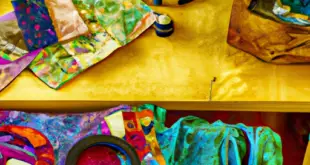Block printing on textiles is a creative and innovative technique that allows beginners to explore the world of fabric design. This step-by-step tutorial aims to provide a comprehensive guide for those who wish to embark on this exciting journey.
By following the instructions outlined in this article, individuals can learn how to choose the right materials and tools, design their block print, carve their block, and ultimately print their unique design on fabric.
The first step towards successful block printing on textiles is selecting the appropriate materials and tools. This aspect is crucial as it sets the foundation for the entire printing process. By carefully considering the type of fabric, ink, and carving tools, beginners can ensure that their designs are printed with precision and durability. The tutorial will provide detailed information on the different options available, allowing individuals to make informed decisions based on their desired outcome.
Designing the block print is another crucial aspect of this tutorial. This step encourages beginners to tap into their creative instincts and explore innovative ideas. By providing guidance on how to conceptualize and sketch designs, this tutorial aims to inspire individuals to think outside the box and create unique patterns and motifs.
The article will also discuss the importance of considering the scale and repetition of the design, as well as techniques to transfer the design onto the block. Ultimately, this section of the tutorial aims to empower beginners to express their individuality and unleash their artistic potential through block printing on textiles.
Choosing the Right Materials and Tools
The selection of appropriate materials and tools is crucial in ensuring a successful and satisfying block printing experience, as it sets the foundation for creating visually captivating and emotionally resonant textile designs.
When choosing materials, it is important to consider the type of fabric that will be used for printing. Natural fibers such as cotton, linen, and silk are commonly preferred due to their ability to absorb the ink and produce vibrant colors. Synthetic fabrics, on the other hand, may not hold the ink as well and can result in lackluster prints. Additionally, the quality of the fabric should be taken into account, as a higher thread count will provide a smoother surface for printing and yield better results.
In terms of tools, the most essential item for block printing is, of course, the block itself. Blocks can be made from various materials such as wood, linoleum, or rubber, each offering different advantages and disadvantages. Wood blocks are traditional and provide a natural texture to the prints, while linoleum blocks are easier to carve and allow for more intricate designs. Rubber blocks, on the other hand, are durable and can be used for both fabric and paper printing.
Other tools that are necessary for block printing include carving tools, ink or paint, a brayer or roller for applying the ink, and a printing surface such as a table or mat. It is important to choose high-quality tools that are suitable for the chosen materials, as they will greatly affect the outcome of the prints.
By selecting the right materials and tools, beginners can lay the groundwork for a successful block printing experience and unleash their creativity in producing unique and visually captivating textile designs.
Designing Your Block Print
To create a captivating and visually appealing block print design, it is crucial to carefully consider the elements of composition, such as line, shape, and color, while keeping in mind the emotional impact it will have on the viewer.
The design of a block print should be innovative and unique, pushing the boundaries of traditional patterns and motifs. By experimenting with different combinations of lines and shapes, artists can create dynamic compositions that draw the eye and evoke a sense of curiosity.
Incorporating bold and contrasting colors can further enhance the visual impact of the design, adding depth and vibrancy to the final print.
When designing a block print, attention to detail is key. Artists should consider the scale and placement of their design elements, ensuring that they work harmoniously within the overall composition. By carefully planning the design, artists can create a sense of balance and rhythm, guiding the viewer’s eye across the print.
Additionally, incorporating intricate details and textures can add an element of surprise and intrigue to the design, making it more visually interesting.
To truly engage the audience, block print designs should strive to be innovative and push the boundaries of traditional techniques. By experimenting with unconventional shapes, patterns, and color combinations, artists can create prints that stand out and capture the imagination of viewers, leaving a lasting impression.
Carving Your Block
When carving a block, attention to detail and precision are crucial in order to achieve intricate and precise designs.
The process of carving involves using specialized tools to carefully remove material from the block’s surface, creating raised areas that will transfer the ink onto the fabric.
It is important to have a clear understanding of the design before starting the carving process, as any mistakes made during this stage can be difficult to correct.
To begin carving, it is advisable to start with the larger, simpler areas of the design and gradually work towards the smaller, more intricate details. This allows for better control and precision in carving.
It is also important to use the correct tools for carving, such as linoleum cutters or wood carving knives, depending on the material of the block. These tools allow for different levels of depth and intricacy, enabling the artist to create various textures and effects in the final print.
In order to achieve the desired level of detail, it is essential to work slowly and methodically, taking breaks to assess progress and make adjustments as needed. This process requires patience and a steady hand, as even the slightest slip or mistake can affect the final outcome.
It is also important to keep the carving tools sharp and clean, as dull tools can lead to imprecise cuts and unwanted marks on the block.
By following these guidelines and paying close attention to detail, artists can create block prints that are not only visually striking but also demonstrate a high level of skill and craftsmanship.
Printing Your Design on Fabric
A crucial step in the process involves transferring the intricately carved design onto fabric, resulting in a visually striking print that showcases the artist’s skill and precision. This step requires careful attention to detail and a steady hand.
To begin, the artist applies a thin layer of fabric paint onto the carved block using a brayer or roller. The block is then carefully placed onto the fabric, ensuring that the design is properly aligned. With even pressure, the artist presses down on the block, transferring the paint onto the fabric. This process may need to be repeated multiple times to ensure that the entire design is printed.
Once the design has been transferred onto the fabric, the artist can marvel at the intricate patterns and textures that have been created. The print may appear slightly different from the carved design due to the natural variations in the fabric and the slight inconsistencies in the printing process. This adds to the unique charm and character of each print.
After the print has dried, it is important to heat set the design to ensure that it remains permanent and doesn’t fade or wash away. This can be done by placing a clean cloth over the print and ironing it on a medium-high heat setting for a few minutes.
The finished fabric can then be used for a variety of purposes, such as clothing, home decor, or art installations, showcasing the artist’s creativity and innovation in block printing.
Conclusion
In conclusion, block printing on textiles is a fascinating art form that allows beginners to create unique designs on fabric.
By carefully choosing the right materials and tools, such as a linoleum block, carving tools, and fabric ink, individuals can embark on this creative journey.
Designing a block print requires careful planning and attention to detail, ensuring that the final design will be visually appealing.
Carving the block is a meticulous process that demands patience and precision, as every stroke affects the final outcome.
Finally, printing the design on fabric is the culmination of all the previous steps, and it is where the artwork comes to life. It is essential to carefully apply the ink to the block and evenly press it onto the fabric to achieve a crisp and vibrant print.
Block printing on textiles offers endless possibilities for artistic expression. Whether it is creating unique patterns, intricate motifs, or bold designs, this technique allows beginners to explore their creativity and produce stunning results.
The step-by-step tutorial outlined above provides a comprehensive guide for anyone interested in trying their hand at block printing on textiles. With practice and dedication, individuals can master this art form and create beautiful, one-of-a-kind pieces.
So, gather your materials, unleash your imagination, and embark on this creative journey of block printing on textiles. The possibilities are boundless, and the results are sure to be truly remarkable.
 printablelabelstemplate
printablelabelstemplate
